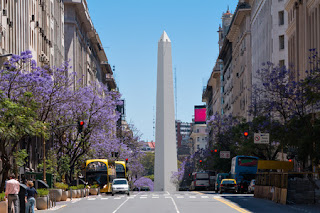 |
| Obelisco de Buenos Aires |
Getting to Know Buenos Aires
Buenos Aires the capital city of Argentina located on the western banks of the Río de la Plata is a multicultural city, being home to multiple ethnic groups. Buenos Aires locals are commonly referred to as 'Porteños', which means 'people of the port'. |
| Map of Río de la Plata |
Buenos Aires has been home to many creative writers and artists, bright-eyed idealists and also dictators, which are all part of its vibrant interesting history.
Foundation of Buenos Aires
The city was founded on February 2, 1536 by a Spanish expedition under Pedro de Mendoza which named the city as Ciudad de la Santísima Trinidad y Puerto de Santa María del Buen Aire (literally 'City of the Most Holy Trinity and Port of Saint Mary of the Fair Winds'). The settlers had to abandon the settlement and move to Asunción, Paraguay in 1541, after being attacked by local indigenous tribes.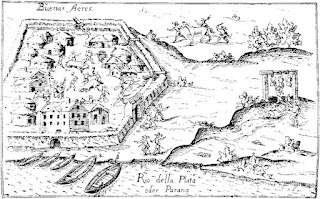 |
| Buenos Aires shortly after its founding in 1536 by Theodor de Bry |
19th century Conflicts and Establishment of Casa Rosada
The Argentinian Republic only emerged after wars against external interests from England and France and internal conflicts in which Federalist and Unitarian factions fought one another.The Unitarians were made up mainly of Buenos Aires businessmen who advocated a centralized government based in the capital. Their intent was to control the foreign commerce conducted from the port of Buenos Aires and benefit from the import tax revenues. The Federalists consisted of regional elites and businessmen whose interests were local and therefore wanted a decentralized state and autonomy for the different regions and provinces.
 |
| Casa Rosada by Karl Kaufmann in 1890 |
The Casa Rosada became the seat of the office of the President.
Development of Infrastructure and Trade
The development of the railroad in the second half of the 19th century and the region’s fertile lowlands created a great deal of grain produce and cattle ranches, which provided raw materials to the city’s factories that exported leather to Europe. By the turn of the century, Buenos Aires was one of the wealthiest cities of the world and had acquired a taste for European high culture. |
| Teatro Colón in 1908 |
The Influx of Immigrants and Its Culinary Influence
As Buenos Aires prospered, the end of the 19th century and beginning of the 20th century, created an influx in European immigrants, mostly from Spain and Italy but also significant number of British, German and Jewish immigrants among others, along with residents of Argentina’s provinces and other bordering countries. |
| Immigrants in Buenos Aires circa 1899 by Frank G. Carpenter |
Traditional Food of Buenos Aires
Beef is the national dish of Argentina and many dishes contain meat prepared in different ways. There are huge cattle ranches in Argentina, and the gaucho, a term for a skilled horseman, reputed to be brave and unruly is a well-known symbol of Argentine individualism. |
| Gauchos at an estancia |
Estancias or ranches play a huge part in Argentina's culture, economy and history. Estancias are also known for their excellent cooking, specially when it comes to the traditional Argentine barbecue called asado, besides other fresh vegetables from the farm. To visitors, estancias also offer a glimpse of the gaucho culture and their daily way of life.
The cuisine of Buenos Aires reflects its multicultural profile as it derives from a mix of different cultures and influences including native Indian ingredients like choclo, a form of corn. Meat is a primary ingredient in many dishes and desserts are an essential part of an Argentine dining experience.
Asado
Asado is used to refer to the traditional Argentine barbecue and usually consists of beef, sausages, and sometimes other meats, which are cooked on a grill, called a parrilla, or an open fire.Asado is more than just delicious grilled meat; it is the way for celebrating special occasions, birthdays, holidays and even weekends with friends and family, emphasizing the importance of social gatherings and the old traditions of the gaucho culture.
 |
| Argentine Asado |
The tradition of eating the offal is said to have originated back in the days when the gauchos could eat as much of the cow as they wanted, as long as they left the valuable hide, which was used to make a variety of products including shoes and clothing.
Some common cuts of meat at an asado include, tira de asado (short ribs), tapa de asado (rib cap), vacío (flank) and bife de chorizo (top loin / sirloin). The most common accompaniment with all cuts of beef is chimichurri, a sauce of herbs, garlic and vinegar.
Milanesas
In its most basic form, the Argentine milanesa is a thin slice of prime beef dipped in breadcrumbs and fried. Milanesa was introduced to South America by the Italian immigrants, and it is a variation of an Italian dish 'Cotoletta alla milanese', one of Milan's signature dishes and similar to the Austrian Wiener Schnitzel.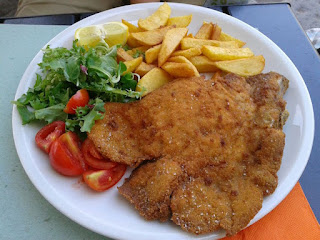 |
| Milanesa |
Another variation of the milanesa, with southern Italian influence of tomatoes is the 'milanesa a la napolitana', a milanesa topped with tomato sauce, cheese and sometimes ham.
Milanesas are usually served with fries, mashed potatoes or salad, and sometimes as a sandwich.
Empanadas
Empanadas are little savory pies stuffed with meat, vegetables and cheeses, often enjoyed as a snack or carried to school for lunch. Empanada comes from the Spanish verb empanar, meaning to wrap or coat in bread. |
| Empanadas cordobesas |
Empanadas are made by folding dough over a stuffing, which may consist of meat, cheese, corn or other ingredients. They are served warm, usually with a dipping sauce like chimichurri made from fresh parsley, garlic, onion, oregano, along with salt and pepper mixed with vinegar and olive oil.
Traditional Drink of Buenos Aires
Though wine and beer are popular drinks with food, while tea and coffee are equally important, the traditional drink of Buenos Aires is an infusion called mate. The name comes from the hollow gourd from which it is traditionally drunk.Mate
Mate is prepared by steeping the yerba leaves in hot water. Unlike tea, the water is not boiling, rather almost to the boiling point, so that the water will not burn the mate leaves making the flavor too bitter and also the hot water will not burn the mouth.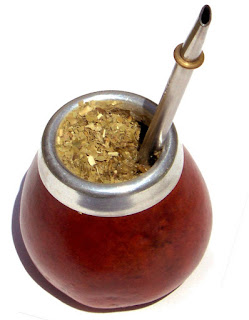 |
| Mate |
Mate has a strong, grassy, bitter, herbal flavor and is an acquired taste, though it can also be flavored with aromatic herbs or dried orange peel.
Other Drinks
Coffee is a popular drink and served strong. Submarino is a hot chocolate, which consists of hot milk, served with a bar of dark chocolate on the side. The chocolate bar is submerged in the glass of hot milk, and as it melts, it creates hot chocolate.Malbec a red wine from Mendoza known for its big bold flavors is the perfect companion for beef dishes, and the Torrontés, an aromatic white Argentine wine with moderate acidity is usually served with fish dishes and pasta.
Quilmes is the national brand of lager style beer, named after the town of Quilmes in the province of Buenos Aires, where the brewery was founded in 1888 by a German immigrant.
Culture of Buenos Aires
The local inhabitants of Buenos Aires commonly referred to as 'Porteños' are warm, friendly and social. They love to eat-out breakfast, lunch, and dinner while also socializing and talking about life and discussing the day's events. |
| Social gathering of porteños |
As most Porteños might have a busy schedule during the week, running different errands, the Sunday family lunch is considered as the most important meal of the week, whose highlights might often include asado.
The warmth and affection of the Porteños, is also displayed in their greeting. It is customary for men and women to kiss each other’s cheeks even it if is the first time they have met each other. They are also very fashionable, given their European influence and culture, and hence enjoy keeping up with the latest fashion trends.
 |
| A football match in Buenos Aires |
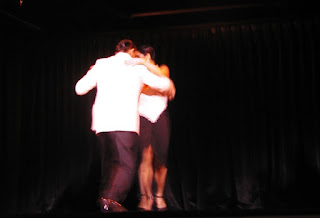 |
| Esquina Carlos Gardel Tango show |
There are also many other dances in Buenos Aires, tango being just one of them, which highlights the multicultural diversity of the city and its rich cultural heritage.
References
Libre del coch by Rupert de Nola (Translation by Robin Carroll-Mann)Article Category: Food & Culture




No comments